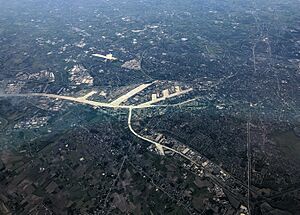Port of Ghent facts for kids
Quick facts for kids Port of Ghent |
|
|---|---|
 |
|
| Location | |
| Country | |
| Location | Ghent, |
| Coordinates | 51°06′21″N 3°44′24″E / 51.10583°N 3.74000°E |
| Statistics | |
| Annual cargo tonnage | 47,712 million tonnes (2014) |
| Annual container volume | 530.823 TEU (2014) |
| Website www.portofghent.be |
|
The Port of Ghent is a very busy seaport in Belgium. It's the third busiest in the country! You can find it in the city of Ghent, which is in the East Flanders region.
For a long time, Ghent has been a city connected to water. Its first port was on the Scheldt river, and then later on the Leie river. Since the Middle Ages, people in Ghent have wanted a way to reach the sea easily. They tried different canals over the centuries: the Lieve canal in the 1200s, the Sassevaart in the 1500s, and the Ghent–Bruges canal in the 1600s.
Today, the Ghent–Terneuzen Canal connects the port to the North Sea. This canal goes through the Western Scheldt river. Big ships, even those as large as "Panamax" size, can use the Port of Ghent. In 2015, plans were made to build a new, even bigger lock at Terneuzen. This new lock will be similar in size to the ones used in the expanded Panama Canal.
Contents
History of Ghent's Seaport Connection
Ghent has always been important for trade, and connecting to the sea was a big goal. Over many centuries, people tried different ways to link the city to the ocean.
Early Canal Attempts
In 1251, the Lieve canal was built. The idea was to connect Ghent to Damme, a town near the Zwin, which was then an arm of the sea. But the Zwin river eventually filled with sand, and by the late 1400s, the Lieve canal was no longer useful.
In 1547, a second attempt was made with the Sassevaart (Sasse Canal). This canal became a very busy trade route. However, in the 1500s, the European wars of religion caused problems. The Dutch blocked traffic on the Western Scheldt and other waterways, stopping ships from using the Sassevaart.
In the 1600s, people tried again with the Ghent–Bruges–Ostend canal. But because old trade rules were removed, there wasn't much activity on this new canal.
The Modern Ghent–Terneuzen Canal
The canal we know today, the Ghent–Terneuzen Canal, was finally built when William I was King of the Netherlands. The plan was approved in 1822, and work started in 1827.
As more ships used the canal and port activities grew, the sea canal was made wider and deeper several times:
- 1880–1881: The Voorhaven and Houtdok docks were dug.
- 1900–1930: The Grootdok was dug, with its Noord-, Midden-, and Zuiddok sections.
- 1931: The Schepen Sifferdok was started.
Work on the Sifferdok was difficult because of the economic crisis in the 1930s and the two World Wars (I and II). After the wars, the lock (a water elevator for ships) was too small for modern ships.
In 1960, Belgium and the Netherlands agreed to build a new, larger sea lock. They also agreed to make the canal big enough for ships up to 80,000 tonnes. In fact, one very large ship, the Alam Permai (87,000 tonnes), has already managed to pass through the existing lock!
Recent Port Expansions
The port continued to grow and expand:
- 1961–1968: The Sifferdok was made longer.
- 1966–1968: The Petroleumdok was dug for oil shipments.
- 1968: The new, larger sea lock was officially opened.
- 1970–1971/1975–1978: The Rodenhuizedok was dug.
- 1996–Today: The Kluizendok has been under construction.
The building of the newest dock, the Kluizendok, marked a new chapter for Ghent. The first part of this work was finished in 1999. This made new quay walls (where ships dock) and land available for businesses. By 2005, the Kluizendok was partly working. It has huge areas for storing goods and for factories that don't need direct access to the sea.
In February 2015, Flanders (a region in Belgium) and the Netherlands signed an agreement to build an even newer, bigger lock at Terneuzen. This project is expected to cost €920 million and be finished around 2021. This new lock will be about the same size as the new, expanded locks in the Panama Canal. This shows how important the Port of Ghent is for trade!
See also
 In Spanish: Puerto de Gante para niños
In Spanish: Puerto de Gante para niños
- Ghent Bio-Energy Valley



